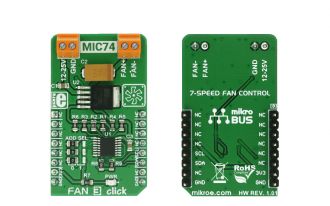
We strongly encourage users to use Package manager for sharing their code on Libstock website, because it boosts your efficiency and leaves the end user with no room for error. [more info]

Rating:
Author: MIKROE
Last Updated: 2018-03-06
Package Version: 1.0.0.0
mikroSDK Library: 1.0.0.0
Category: Brushless
Downloaded: 6193 times
Not followed.
License: MIT license
Fan 3 click is the perfect choice for speed control and it can operate in seven discrete speed steps. Fan 3 click works with 12V to 25V on its input connector and can be used whenever a noiseless solution with a variable fan speed is needed, for example - cooling of electronic components with the minimal possible noise produced.
Do you want to subscribe in order to receive notifications regarding "Fan 3 click" changes.
Do you want to unsubscribe in order to stop receiving notifications regarding "Fan 3 click" changes.
Do you want to report abuse regarding "Fan 3 click".


Library Description
The library contains a function that controls the operation of Fan 3 click.
Key functions
void fan3_setSpeed(uint8_t newSpeed)- Controls the fan speed
Examples Description
The application is composed of three sections :
mikrobus_logWrite("Speed 1...",_LOG_LINE); fan3_setSpeed(_FAN3_SPEED1); Delay_ms( 4000 ); mikrobus_logWrite("Speed 3...",_LOG_LINE); fan3_setSpeed(_FAN3_SPEED3); Delay_ms( 4000 ); mikrobus_logWrite("Speed 5...",_LOG_LINE); fan3_setSpeed(_FAN3_SPEED5); Delay_ms( 4000 ); mikrobus_logWrite("Speed 7...",_LOG_LINE); fan3_setSpeed(_FAN3_SPEED7); Delay_ms( 4000 ); mikrobus_logWrite("Stopped...",_LOG_LINE); fan3_setSpeed(_FAN3_STOPPED); Delay_ms( 4000 );
Other MikroElektronika libraries used in the example:
Additional notes and information
Depending on the development board you are using, you may need USB UART click, USB UART 2 click or RS232 click to connect to your PC, for development systems with no UART to USB interface available on the board. The terminal available in all MikroElektronika compilers, or any other terminal application of your choice, can be used to read the message.